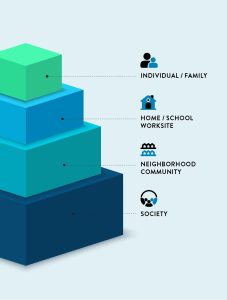Chapter 3: Social Determinants of Health
Overview
Mei, age 11, lives in an apartment in the city with her family. Every day, they hear the noise of cars, trucks, and buses driving past their home. As Mei and her younger sister, Chao, walk to school, they cross many busy streets. The school provides breakfast and lunch for all students, but the funding for these meals is ending soon. After school, Mei takes Chao to the corner park to play with neighborhood children, unless Chao’s asthma flares up. In the evening, their mother arrives home from work before their father and makes dinner for the family. Then, the girls do homework and go to bed. On weekends and school vacations, the family likes to explore parks and natural areas outside the city.
Many aspects of our daily lives influence our health. Beyond physical activity and genetics, environmental, sociological, and cultural factors can have profound effects on physical, mental, and emotional health. In the above scenario, Mei and her family may experience traffic pollutants and other environmental exposures from living in the city. They may also experience structural and institutional racism, along with disparities that affect their environments, education, and careers. On a positive note, exposure to nature in the local park and while on vacation can benefit Mei and Chao’s health. Social connections through family, friends, and the community, as well as cultural and religious support, can also have positive effects on health.
In this chapter, you will be introduced to the ways in which our decisions, families, schools, communities, and cultures affect our health through what are called social determinants of health. You will learn how public health programs and campaigns use primary, secondary, and tertiary interventions to help communities lower their risk for certain illnesses. You will also explore ways in which different communities may be at increased risk for illness and investigate your own social determinants of health. This will help you understand how factors beyond exposure to infectious diseases may impact your health and that of your patients.
Objectives
Upon completion of this chapter, the learner will be able to:
- Define health
- Explain how social determinants of health might influence mortality and morbidity rates in the United States
- Survey strategies to improve social determinants of health
- Compare and contrast sociocultural, physical, accessible, biological, and behavioral determinants of health
- Identify disparities in the healthcare field
- Discuss healthcare equity and the issues that cause it
- Apply knowledge of diverse demographics and culture to decrease barriers to care
Key Terms
- Community
- Culture
- Health
- Primary intervention
- Public health
- Racism
- Secondary intervention
- Social determinants of health
- Society
- Tertiary intervention
Attributions
- Chapter opening image by Hannah Adams released under CC BY-4.0


